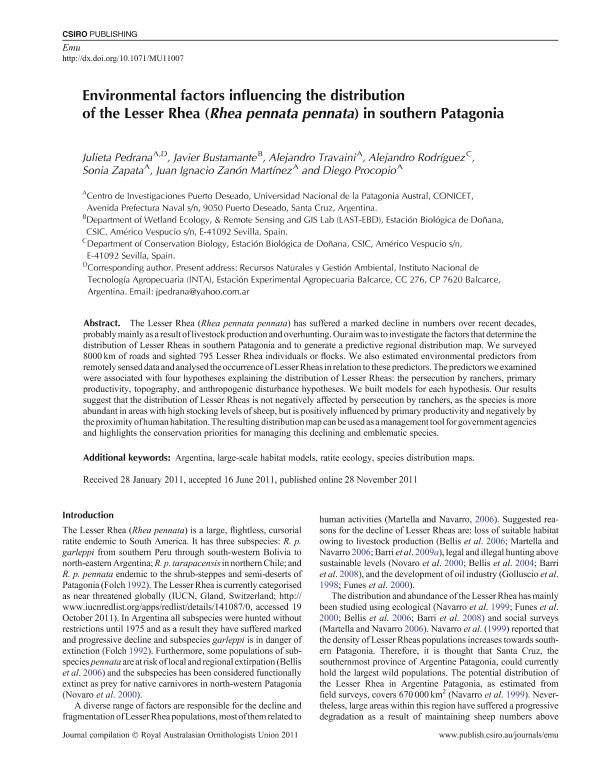Artículo
Environmental factors influencing the distribution of the Lesser Rhea (Rhea pennata pennata) in southern Patagonia
Pedrana, Julieta ; Bustamante, Javier; Travaini, Alejandro
; Bustamante, Javier; Travaini, Alejandro ; Rodrguez, Alejandro; Zapata, Sonia Cristina; Zanón Martínez, Juan Ignacio
; Rodrguez, Alejandro; Zapata, Sonia Cristina; Zanón Martínez, Juan Ignacio ; Procopio, Diego Esteban
; Procopio, Diego Esteban
 ; Bustamante, Javier; Travaini, Alejandro
; Bustamante, Javier; Travaini, Alejandro ; Rodrguez, Alejandro; Zapata, Sonia Cristina; Zanón Martínez, Juan Ignacio
; Rodrguez, Alejandro; Zapata, Sonia Cristina; Zanón Martínez, Juan Ignacio ; Procopio, Diego Esteban
; Procopio, Diego Esteban
Fecha de publicación:
11/2011
Editorial:
Taylor & Francis
Revista:
Emu
ISSN:
0158-4197
Idioma:
Inglés
Tipo de recurso:
Artículo publicado
Clasificación temática:
Resumen
The Lesser Rhea (Rhea pennata pennata) has suffered a marked decline in numbers over recent decades, probably mainly as a result of livestock production and overhunting. Our aim was to investigate the factors that determine the distribution of Lesser Rheas in southern Patagonia and to generate a predictive regional distribution map. We surveyed 8000km of roads and sighted 795 Lesser Rhea individuals or flocks. We also estimated environmental predictors from remotely sensed data and analysed the occurrence of Lesser Rheas in relation to these predictors. The predictors we examined were associated with four hypotheses explaining the distribution of Lesser Rheas: the persecution by ranchers, primary productivity, topography, and anthropogenic disturbance hypotheses. We built models for each hypothesis. Our results suggest that the distribution of Lesser Rheas is not negatively affected by persecution by ranchers, as the species is more abundant in areas with high stocking levels of sheep, but is positively influenced by primary productivity and negatively by the proximity of human habitation. The resulting distribution map can be used as a management tool for government agencies and highlights the conservation priorities for managing this declining and emblematic species.
Archivos asociados
Licencia
Identificadores
Colecciones
Articulos(INCITAP)
Articulos de INST.D/CS D/L/TIERRA Y AMBIENTALES D/L/PAMPA
Articulos de INST.D/CS D/L/TIERRA Y AMBIENTALES D/L/PAMPA
Citación
Pedrana, Julieta; Bustamante, Javier; Travaini, Alejandro; Rodrguez, Alejandro; Zapata, Sonia Cristina; et al.; Environmental factors influencing the distribution of the Lesser Rhea (Rhea pennata pennata) in southern Patagonia; Taylor & Francis; Emu; 111; 4; 11-2011; 350-359
Compartir
Altmétricas



